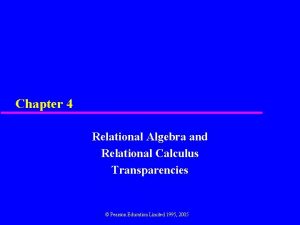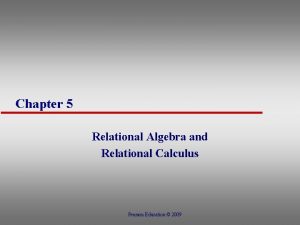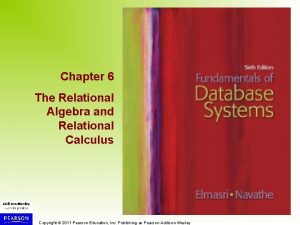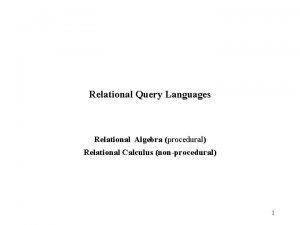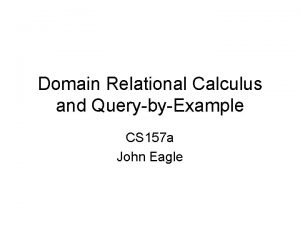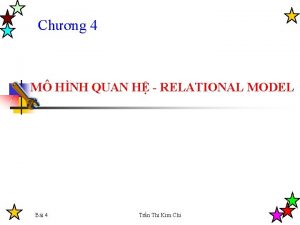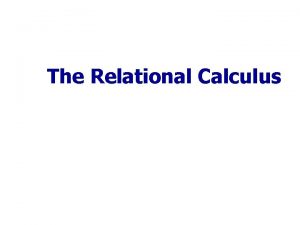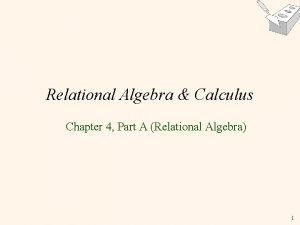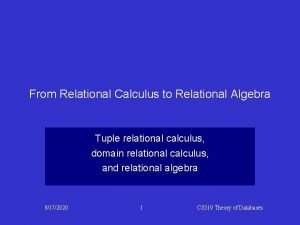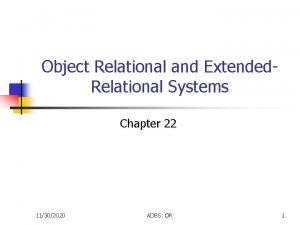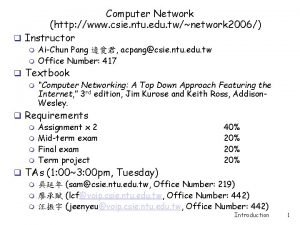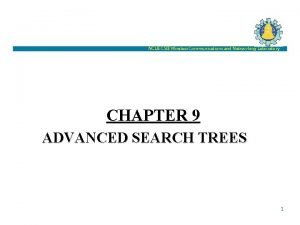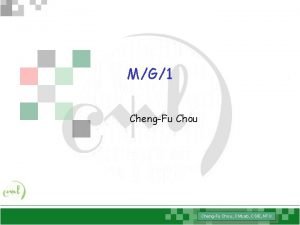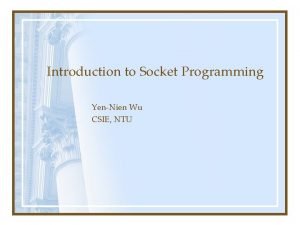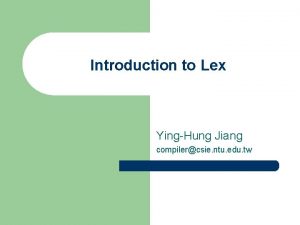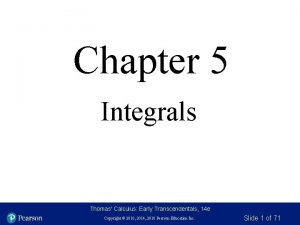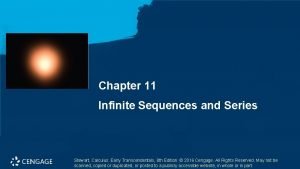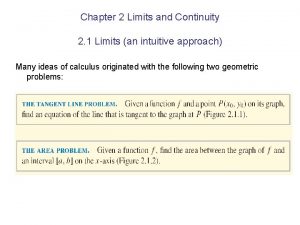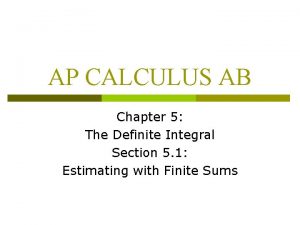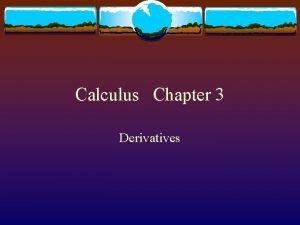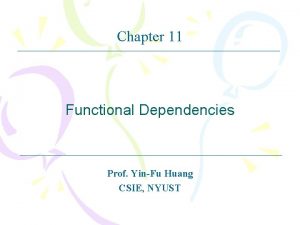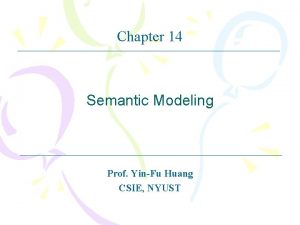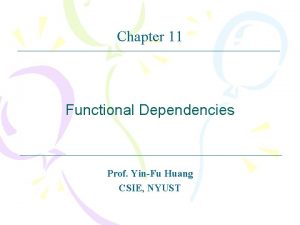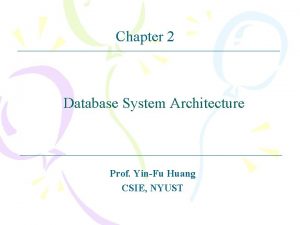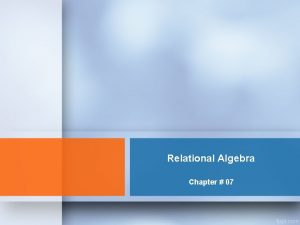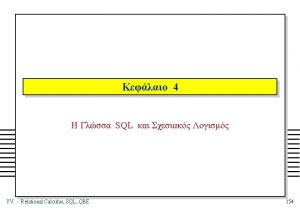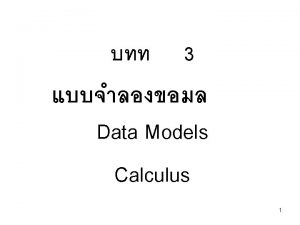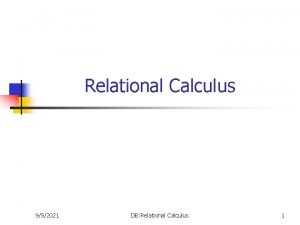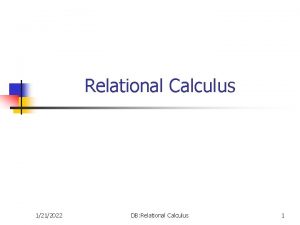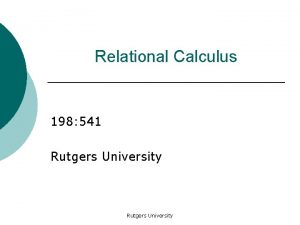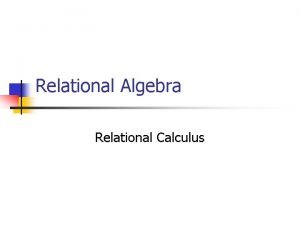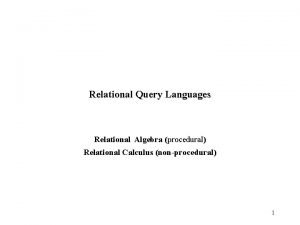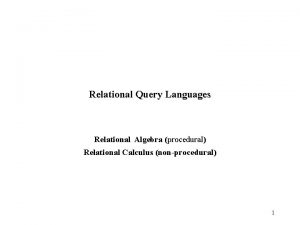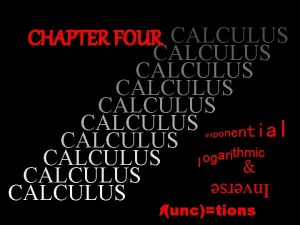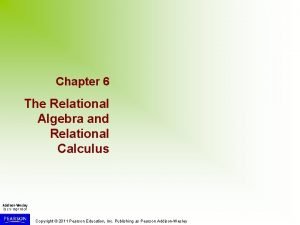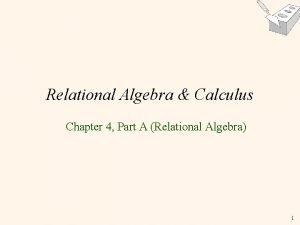Chapter 8 Relational Calculus Prof YinFu Huang CSIE






























- Slides: 30

Chapter 8 Relational Calculus Prof. Yin-Fu Huang CSIE, NYUST

8. 1 Introduction n The algebra provides a set of explicit operators that can be used to tell the system how to construct some desired relation from certain given relations. n The calculus merely provides a notation for stating the definition of that desired relation in terms of those given relations. n The query “Get supplier numbers and cities for suppliers who supply part P 2” Ø Algebra: 1. join supplier and shipment over S#. 2. restrict the result of that join to tuples for part P 2. 3. project the result of that restriction over S# and City. Ø Calculus: Get S# and City for suppliers such that there exists a shipment Sp with the same S# value and with P# value P 2. Advanced Database System 2

8. 1 Introduction (Cont. ) n n prescriptive (Algebra) vs. descriptive (Calculus) procedural (Algebra) vs. nonprocedural (Calculus) The algebra and the calculus are logically equivalent. Relation calculus is based on a branch of mathematical logic called predicate calculus. n Tuple calculus: range variables over relations n Language called QUEL Range of Sx Is S; Retrieve (Sx. S#) Where Sx. City=“London”; n Domain calculus: range variables over domains n Language called Query-By-Example (QBE) Advanced Database System 3

8. 2 Tuple Calculus n Syntax (See Page 215 -216) <relation exp> : : = Relation {<tuple exp commalist>} | <relvar name> | <relation op inv> | <with exp> | <introduced name> | (<relation exp>) <range var def> : : = Rangevar <range var name> Ranges Over <relation exp commalist>; <range attribute ref> : : = <range var name>. <attribute name> [ As <attribute name> ] Advanced Database System 4

8. 2 Tuple Calculus (Cont. ) <bool exp> : : = …all the usual possibilities, together with: | <quantified bool exp>: : = <quantifier> <range var name> ( <bool exp> ) <quantifier> : : = Exists | Forall <relation op inv> : : = <proto tuple> [ Where <bool exp> ] <proto tuple> : : = …see the body of the text Advanced Database System 5

8. 2 Tuple Calculus (Cont. ) n Range variables e. g. Rangevar Sx Ranges Over S; Rangevar Spx Ranges Over Sp; Rangevar Su Ranges Over ( Sx Where Sx. City = ‘London’ ), ( Sx Where Exists Spx ( Spx. S# = Sx. S# And Spx. P# = P#(‘P 1’) ) ); Advanced Database System 6

8. 2 Tuple Calculus (Cont. ) n Free and bound variable references Let V be a range variable Ø References to V in Not p ⇒ according as they are free or bound in p Ø References to V in p And q and p Or q ⇒ according as they are free or bound in p or q Ø References to V that are free in p are bound in Exists V (p) and Forall V (p) Advanced Database System 7

8. 2 Tuple Calculus (Cont. ) Examples Sx. S#=S#(‘S 1’) Sx. S#=Spx. S# Spx. P#≠Px. P# ⇒ Sx, Px, and Spx are free Px. Weight < Weight(15. 5) And Px. City=’Oslo’ Not (Sx. City=‘London’) Sx. S#=Spx. S# And Spx. P#≠Px. P# Px. Color=Color(‘Red’) Or Px. City=‘London’ ⇒ Sx, Px, and Spx are free Exists Spx (Spx. S#=Sx. S# And Spx. P#=P#(‘P 2’)) Forall Px (Px. Color=Color(‘Red’)) ⇒ Spx and Px are bound and Sx is free. Advanced Database System 8

8. 2 Tuple Calculus (Cont. ) n Quantifiers Exists V ( p (V) ) ⇒ False Or p(t 1) Or. . . Or p(tm) Forall V ( p(V) ) ⇒ True And p(t 1) And. . . And p(tm) n Free and bound variable references revisited Exists x ( x > 3 ) ⇔ Exists y ( y > 3 ) Exists x ( x > 3 ) and x < 0 ⇔ Exists y ( y > 3 ) and x < 0 Exists y ( y > 3 ) and y < 0 Advanced Database System 9

8. 3 Examples n Exam 1: {Sx. S#, Sx. Status} Where Sx. City=‘Paris’ And Sx. Status > 20 n Exam 2: {Sx. S# As Sa, Sy. S# As Sb} Where Sx. City=Sy. City And Sx. S# < Sy. S# n Exam 3: Sx Where Exists Spx (Spx. S#=Sx. S# And Spx. P#=P#(‘P 2’)) n Exam 4: Sx. Sname Where Exists Spx (Sx. S#=Spx. S# And Exists Px (Px. P#=Spx. P# And Px. Color=Color(‘Red’))) n Exam 5: Sx. Sname Where Exists Spx ( Exists Spy (Sx. S#=Spx. S# And (Spx. P#=Spy. P# And Spy. S#=S#(‘S 2’))) Advanced Database System 10

8. 3 Examples (Cont. ) n Exam 6: Sx. Sname Where Forall Px ( Exists Spx (Spx. S#=Sx. S# And Spx. P#=Px. P#)) n Exam 7: Sx. Sname Where Not Exists Spx (Spx. S#=Sx. S# And Spx. P#=P#(‘P 2’)) n Exam 8: Sx. S# Where Forall Spx (Spx. S#≠S#(‘S 2’) Or Exists Spy (Spy. S#=Sx. S# And Spy. P#=Spx. P#)) If p Then q End If ⇔ (Not p) Or q n Exam 9: Rangevar Pu Ranges Over (Px. P# Where Px. Weight > Weight(16. 0)), (Spx. P# Where Spx. S#=S#(‘S 2’)); Pu. P# Advanced Database System 11

8. 4 Calculus vs. Algebra n The algebra is at least as powerful as the calculus. n Codd‘s reduction algorithm: by which an arbitrary expression of the calculus could be reduced to a semantically equivalent expression of the algebra. n Example Query: Get names and cities for suppliers who supply at least one Athens project with at least 50 of every part. A calculus expression: {Sx. Sname, Sx. City} Where Exists Jx Forall Px Exists Spjx { (Jx. City=‘Athens’ And Jx. J#=Spjx. J# And Px. P#=Spjx. P# And Sx. S#=Spjx. S# And Spjx. Qty≧Qty ( 50 ) ) Advanced Database System 12

8. 4 Calculus vs. Algebra (Cont. ) (See Page 226 -228 & Fig. 8. 1) Step 1: Advanced Database System 13

8. 4 Calculus vs. Algebra (Cont. ) Step 2: Cartesian product 5*6*2*24 =1440 tuples Step 3: Restriction Jx. J#=Spjx. J# And Px. P#=Spjx. P# And Sx. S#=Spjx. S# Advanced Database System 14

8. 4 Calculus vs. Algebra (Cont. ) Step 4: Apply the quantifiers from right to left Exists V ⇒ project the current intermediate result to eliminate all attributes of relation r. Forall V ⇒ divide the current intermediate result by the “restricted range” relation associated with V. Step 5: Projection Advanced Database System 15

8. 4 Calculus vs. Algebra (Cont. ) n Why Codd defined precisely the eight algebraic operators? 1. Inherently implementable 2. A yardstick for measuring the expressive power of any given database language n A language is said to be relationally complete if it is at least as powerful as the calculus. n Any given language L is complete, if it is sufficient to show that L includes analogs of each of the eight algebraic operators. e. g. SQL n Relational completeness does not necessarily imply any other kind of completeness. Advanced Database System 16

8. 5 Computational Capabilities n Exam 1: {Px. P#, Px. Weight*454 As Gmwt} Where Px. Weight*454 > Weight(10000. 0) n Exam 2: {Sx, ‘Supplier’ As Tag} n Exam 3: {Spx, Px. Weight*Spx. Qty As Shipwt} Where Px. P#=Spx. P# n Exam 4: {Px. P#, Sum(Spx Where Spx. P#=Px. P#, Qty) As Totqty} n Exam 5: Sum(Spx, Qty) As Grandtotal n Exam 6: {Sx. S#, Count(Spx Where Spx. S#=Sx. S#) As #_Of_Part} n Exam 7: Rangevar Py Ranges Over P; Px. City Where Count (Py Where Py. City=Px. City And Py. Color=(‘Red’)) > 5 Advanced Database System 17

8. 6 SQL Facilities n Exam 1: Select Px. Color, Px. City From P As Px Where Px. City <> ‘Paris’ And Px. Weight > Weight (10. 0); n Exam 2: Select P. P#, P. Weight*454 As Gmwt From P; n Exam 3: 1. Select S. *, P. P#, P. Pname, P. Color, P. Weight From S, P Where S. City=P. City; 2. S Join P Using City; 3. S Natural Join P; n Exam 4: Select Distinct S. City As Scity, P. City As Pcity From S Join SP Using S# Join P Using P#; n Exam 5: Select A. S# As Sa, B. S# As Sb From S As A, S As B Where A. City=B. City And A. S# < B. S#; Advanced Database System 18

8. 6 SQL Facilities (Cont. ) n Exam 6: Select Count(*) As N From S; n Exam 7: Select Max(Sp. Qty) As Maxq, Min(Sp. Qty) As Minq From Sp Where Sp. P#=P#(‘P 2’); n Exam 8: Select Sp. P#, Sum(Sp. Qty) As Totqty From Sp Group By Sp. P#; n Exam 9: Select Sp. P# From Sp Group By Sp. P# Having Count(Sp. S#) > 1; n Exam 10: Select Distinct S. Sname From S Where S. S# In (Select Sp. S# From Sp Where Sp. P#=P#(‘P 2’)); Advanced Database System 19

8. 6 SQL Facilities (Cont. ) n Exam 11: Select Distinct S. Sname n Exam 13: Select Distinct S. Sname From S Where S. S# In Where Exists (Select Sp. S# (Select * From Sp Where Sp. P# In Where Sp. S#=S. S# (Select P. P# And Sp. P#=P#(‘P 2’)); From P Where P. Color=Color(‘Red’))); n Exam 12: Select S. S# From S Where S. Status < (Select Max(S. Status) From S); Advanced Database System 20

8. 6 SQL Facilities (Cont. ) n Exam 14: Select Distinct S. Sname n Exam 16: From S Where Not Exists (Select * From Sp Where Sp. S#=S. S# And Sp. P#=P#(‘P 2’)); Select P. P# From P Where P. Weight > P#(16. 0) Union Select Sp. P# From Sp Where Sp. S#=S#(‘S 2’) n Exam 17: n Exam 15: Select Distinct S. Sname With T 1 As From S (Select P. P#, P. Weight*454 As Gmwt Where Not Exists From P) (Select * Select T 1. P#, T 1. Gmwt From P From T 1 Where Not Exists Where T 1. Gmwt > Weight(10000. 0); (Select * From Sp Where Sp. S#=S. S# And Sp. P#=P. P#)); Advanced Database System 21

8. 7 Domain Calculus n The most immediately obvious difference between the domain and the tuple calculus is that the former supports an additional form of <bool exp> called a membership condition. R { <pair commalist> } e. g. Sx Sx Where S {S# Sx} Sx Where S {S# Sx, City ‘London’} {Sx, Cityx} Where S {S# Sx, Cityx} And Sp {S# Sx, P# P#(‘P 2’)} {Sx, Px} Where S {S# Sx, Cityx} And P {P# Px, Cityy} And Cityx≠Cityy Advanced Database System 22

8. 7 Domain Calculus (Cont. ) n Exam 1: Sx Where Exists Statusx (Statusx > 20 And S {S# Sx, Statusx, City ‘Paris’}) n Exam 2: {Sx As Sa, Sy As Sb} Where Exists Cityz (S {S# Sx, Cityz} And S {S# Sy, Cityz} And Sx < Sy) n Exam 3: Namex Where Exists Sx Exists Px (S {S# Sx, Sname Namex} And Sp {S# Sx, P# Px} And P {P# Px, Color(‘Red’)}) n Exam 4: Namex Where Exists Sx Exists Px (S {S# Sx, Sname Namex} And Sp {S# Sx, P# Px} And Sp {S# S#(‘S 2’), P# Px}) Advanced Database System 23

8. 7 Domain Calculus (Cont. ) n Exam 5: Namex Where Exists Sx (S {S# Sx, Sname Namex} And Forall Px (If P {P# Px} Then Sp {S# Sx, P# Px} End If)) n Exam 6: Namex Where Exists Sx (S {S# Sx, Sname Namex} And Not Sp {S# Sx, P# P#(‘P 2’)}) n Exam 7: Sx Where Forall Px (If Sp {S# S#(‘S 2’), P# Px} Then Sp {S# Sx, P# Px} End If) n Exam 8: Px Where Exists Weightx (P {P# Px, Weightx} And Weightx > Weight(16. 0)) Or Sp {S# S#(‘S 2’), P# Px} Advanced Database System 24

8. 8 Query-By-Example n Exam 1: S S# Sname P. n Exam 2: SP S# UNQ. n Exam 3: Status City > 20 Paris P# Qty P. S S# Status City P. AO(2). P. DO(1). Paris n Exam 4: S S# Status P. P. City Paris > 20 Advanced Database System 25

8. 8 Query-By-Example (Cont. ) n Exam 5: n Exam 6: P P P# Weight P. >= 16. 0 <= 19. 0 P# Weight Gmwt P. _PW P. _PW * 454 S# Sname _SX P. S# City _SX _CX n Exam 7: S SP S# P# _SX P 2 n Exam 8: S P P# City _PX _CX Advanced Database System P. _SX _PX 26

8. 8 Query-By-Example (Cont. ) n Exam 9: S S# City _SX _CZ _SY _CZ P. _SX _SY n Exam 10: SP n Exam 11: SP S# S# P# Qty P 2 _QX P# Qty G. P. _QY P. SUM. _QX P. SUM. _QY n Exam 12: SP S# P# Conditions _SX G. P. CNT. _SX > 1 Advanced Database System 27

8. 8 Query-By-Example (Cont. ) n Exam 13: P P# Weight _PX > 16. 0 SP S# P# S 2 _PY P. _PX P. _PY n Exam 14: n Exam 15: P P# I. P 7 SP S# Pname Color Weight 24. 0 P# City Athens Qty D. > 300 n Exam 16: P P# P 2 Pname Color Weight City U. Yellow _WT U. _WT+5 U. Oslo Advanced Database System 28

8. 8 Query-By-Example (Cont. ) n Exam 17: SP S# Qty _SX U. 5 S S# City _SX London Advanced Database System 29

The End. Advanced Database System 30
 Relational calculus
Relational calculus Relational calculus
Relational calculus Relational calculus symbols
Relational calculus symbols Relational query language
Relational query language Cs 157
Cs 157 Relational calculus calculator
Relational calculus calculator Relational calculus
Relational calculus Calculus
Calculus Expressive power of algebra and calculus
Expressive power of algebra and calculus Tuple relational calculus
Tuple relational calculus Object relational and extended relational databases
Object relational and extended relational databases Vpn ntu
Vpn ntu Cgu csie
Cgu csie Csie ntu
Csie ntu Irssi screen
Irssi screen Ccu csie
Ccu csie Csie.nctu.edu.tw login
Csie.nctu.edu.tw login Max heap
Max heap Ccbsd
Ccbsd Csie.nctu.edu.tw mail
Csie.nctu.edu.tw mail Ncnu csie
Ncnu csie Csie.ntu
Csie.ntu Poker bet challenge
Poker bet challenge Bill fenner
Bill fenner Ntu csie vpn
Ntu csie vpn Calculus chapter 5
Calculus chapter 5 Stewart
Stewart Chapter 2 limits and continuity
Chapter 2 limits and continuity Ap calc ab chapter 5
Ap calc ab chapter 5 Pre calculus chapter 1
Pre calculus chapter 1 Calculus chapter 3
Calculus chapter 3
